Key takeaways:
- Animal drama workshops foster empathy and understanding by allowing participants to embody animals, helping them to connect emotionally and reflect on issues like abandonment and rescue.
- Education on animal protection dismantles misconceptions and encourages critical thinking about ethical treatment, leading to advocacy and actions for animal welfare.
- Engaging activities, like crafting masks and storytelling, create safe spaces for emotional exploration, enabling participants to reflect on their responsibilities toward animals.
- Feedback from participants after workshops reveals tangible shifts in attitudes and commitments to animal advocacy, driving continuous improvement in workshop facilitation.
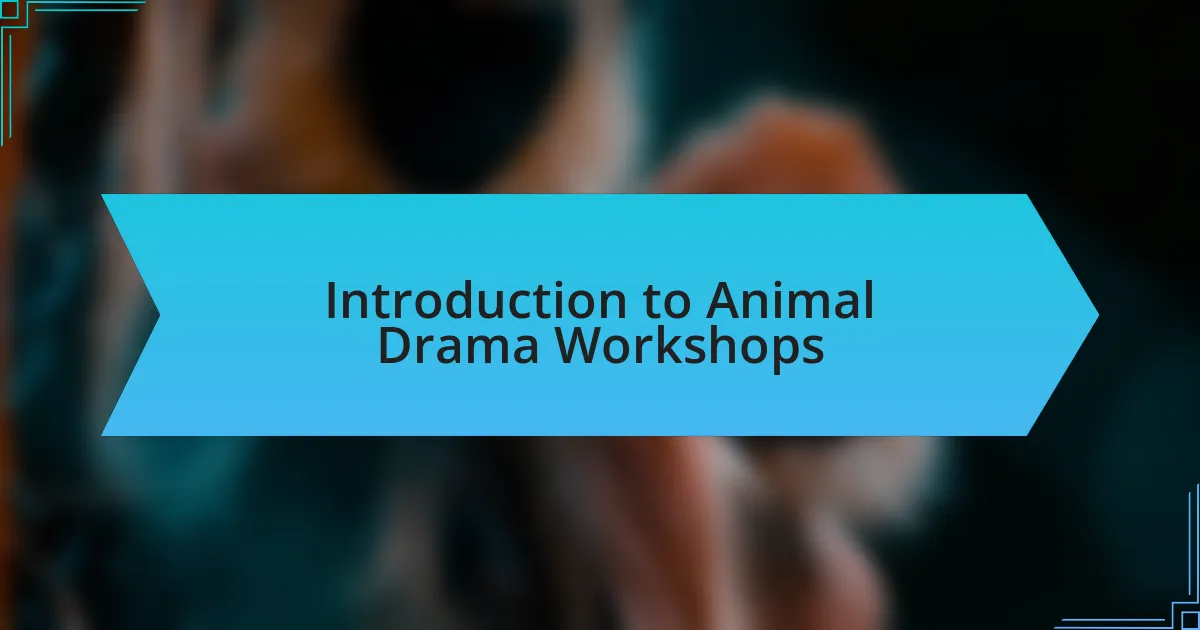
Introduction to Animal Drama Workshops
Animal drama workshops provide a unique platform for exploring the emotional landscapes of our furry friends. I recall the first time I facilitated a workshop; participants were hesitant, unsure how to embody animals authentically. But as we dove deeper into the exercises, the room buzzed with energy, transforming into a symphony of barks, purrs, and flutters that reminded everyone of the connectedness we share with the animal kingdom.
By engaging in role-play, participants often discover their empathy for animals in ways that words alone cannot convey. In one instance, a participant described feeling the weight of a stray dog’s fear as they acted out the character, which sparked a profound discussion about abandonment and rescue. Isn’t it fascinating how stepping into another’s shoes—especially those with fur, feathers, or scales—can open our hearts and minds?
These workshops go beyond mere performance; they cultivate a deep respect for the lives of animals, prompting participants to ponder questions like, “What does it feel like to be voiceless?” I believe it’s this kind of introspection that fosters compassion and drives meaningful action toward animal welfare, truly aligning our emotions with their struggles and joys.

Importance of Animal Protection Education
Education about animal protection is crucial in shaping our understanding of the responsibilities we have toward our fellow creatures. During one workshop, I witnessed a participant who had grown up with a deep-seated fear of large dogs. Through guided exercises, she learned to connect with a dog’s perspective and, surprisingly, found herself seeing them as gentle giants rather than threats. This transformation opened her heart, demonstrating how education can help dismantle misconceptions and foster empathy.
Moreover, discussing the ethical implications of animal treatment creates a space for critical thinking. I remember sparking a debate on the impact of factory farming during one session; participants grappled with the harsh realities animals face for our consumption. Questions bubbled to the surface—can we justify such suffering for our convenience? This dialogue pushed everyone to consider their choices and the larger picture of animal welfare, emphasizing that education is not merely informative but transformative.
Through workshops, I’ve seen firsthand how these conversations create advocates for the voiceless. Each story shared in the room—be it about rescue animals or wildlife conservation—reinforces the idea that when we listen and learn, we become more than mere observers; we become passionate participants in the fight for animal rights. Isn’t it incredible how the act of educating ourselves can catalyze change?
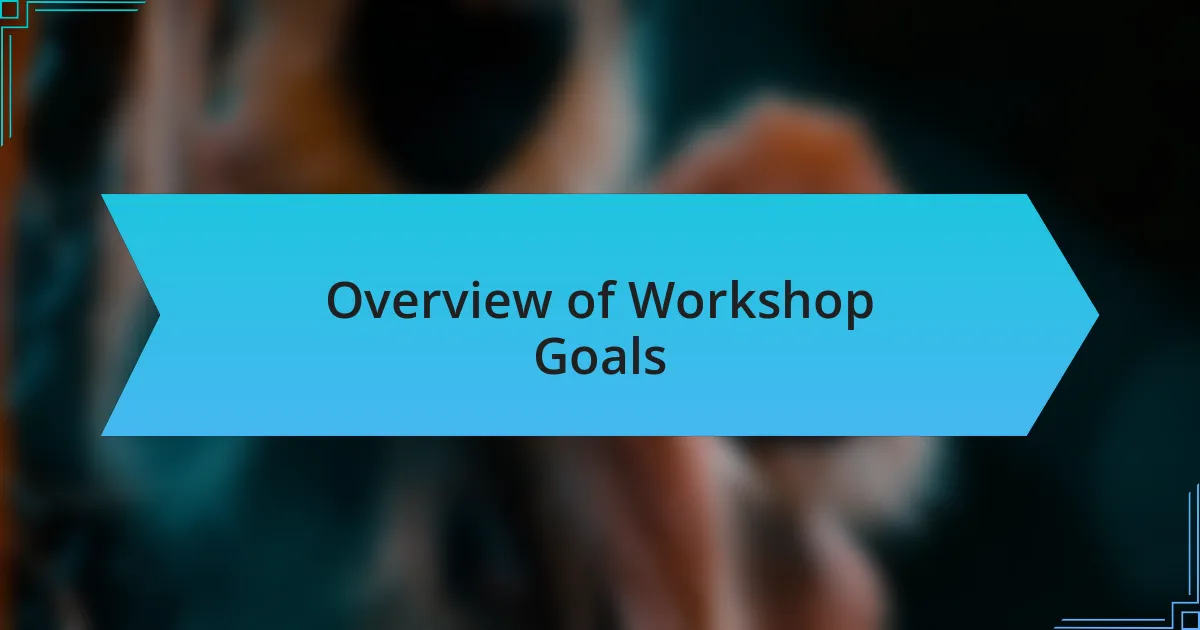
Overview of Workshop Goals
One of the primary goals of the workshops is to foster a deep understanding of animals’ emotional and social needs. I often notice participants are surprised by how much animals communicate non-verbally, using body language and vocalizations to express their feelings. Encouraging them to recognize these signals not only enhances empathy but also reinforces the importance of responsible pet ownership.
Another key goal is to inspire participants to take action in their communities. I recall a participant who was moved by a story of a local shelter’s struggles. After the workshop, she organized a donation drive, illustrating that awareness can lead to tangible change. When individuals realize their ability to impact the world around them, they become catalysts for positive progress in animal welfare.
Lastly, I aim to create a safe space for sharing experiences while igniting passion for animal advocacy. During these workshops, participants sometimes share heartrending stories about animals they’ve encountered, and these moments create strong emotional connections. Isn’t it fascinating how collective storytelling can unite us in a common cause, making us all feel like part of something bigger?
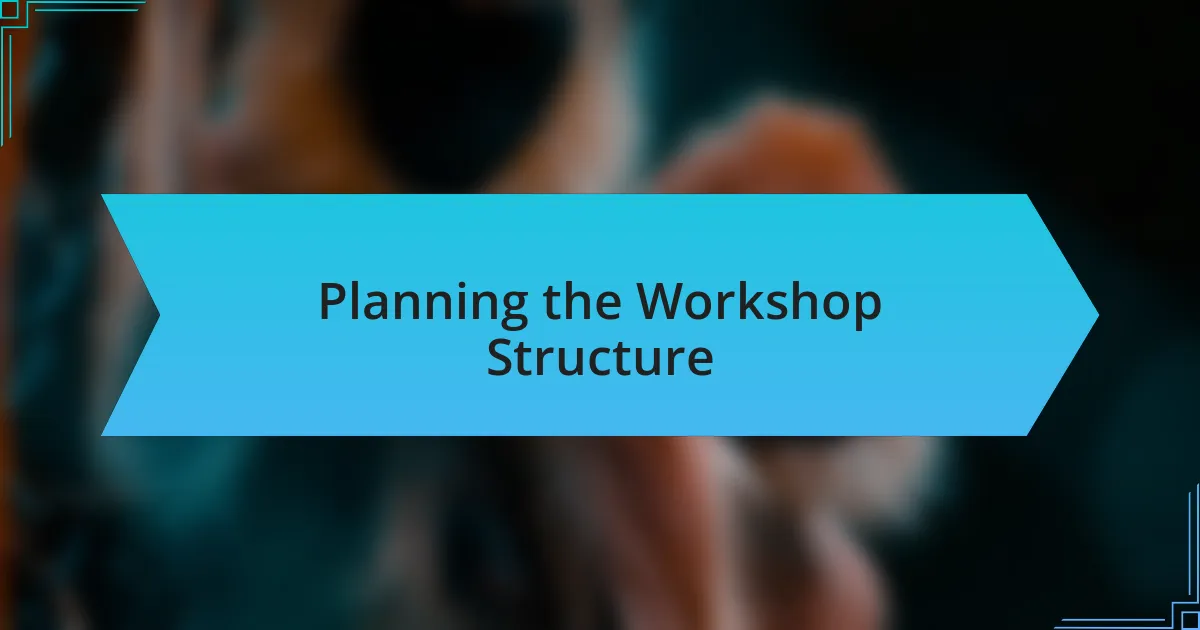
Planning the Workshop Structure
When planning the structure of the workshops, I start by establishing a clear timeline that outlines each activity. I find that a well-paced schedule keeps participants engaged while allowing ample time for discussions and activities, which are crucial for building connection. For instance, incorporating a short icebreaker at the beginning not only sets a friendly tone but also encourages participants to open up about their experiences with animals, fostering an immediate sense of community.
Choosing a variety of activities is another important aspect of the structure. I like to mix hands-on exercises with more reflective tasks, as each format appeals to different learning styles. There’s something powerful about seeing participants light up during a role-playing exercise where they embody animals. It sparks laughter and deeper understanding simultaneously. Have you ever witnessed that shift in perspective when someone steps into an animal’s shoes, even if just for a moment? It’s remarkable how empathy blooms in such creative environments.
Finally, I ensure that there’s flexibility in the workshop structure to adapt to the group’s needs. While having a plan is essential, I’ve often made adjustments on the fly based on the energy and engagement levels of participants. For example, if a discussion becomes particularly passionate, I’m always ready to extend that conversation at the expense of less critical activities. It just goes to show that being responsive in the moment can lead to unexpected insights and deeper connections. Isn’t that the essence of effective teaching?
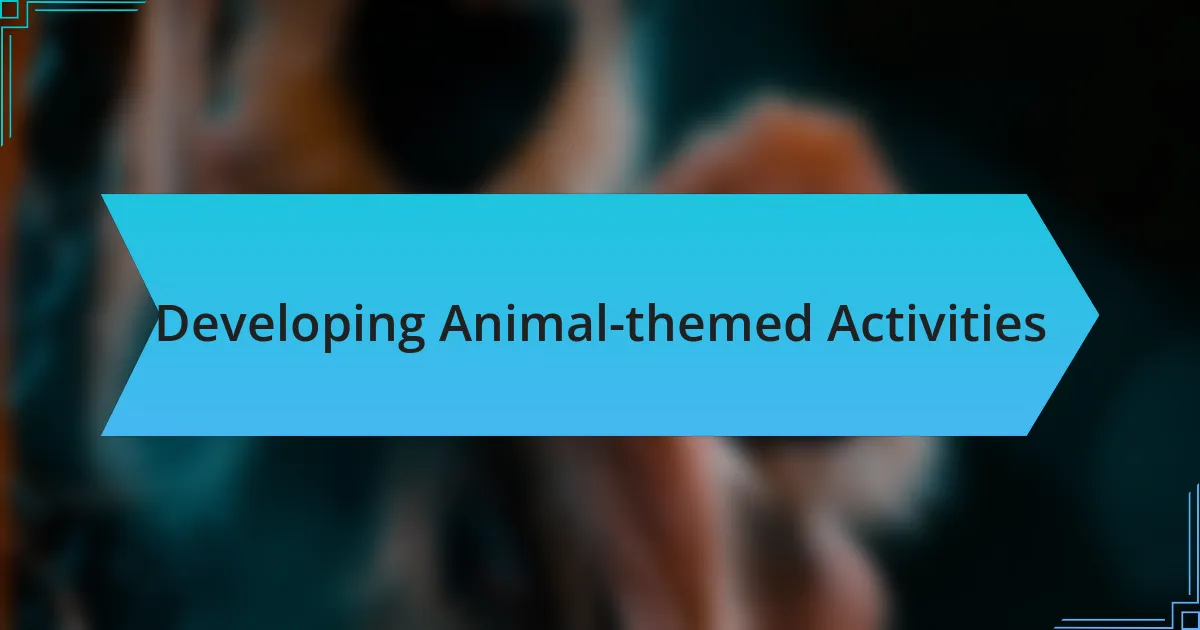
Developing Animal-themed Activities
Creating animal-themed activities is about tapping into participants’ emotions as much as their intellect. One memorable activity I developed involved crafting animal masks from simple materials. As participants transformed into their chosen animals, I watched their expressions change. It was fascinating to see how those masks allowed them to explore their identities in a way that felt safe and playful. Have you ever noticed how liberating it is to step outside ourselves, even for a brief moment? It can create a profound shift in understanding.
Another successful activity I implemented involved storytelling sessions where participants shared their personal experiences with animals. It was not just about the stories themselves; it was the heartfelt connections that formed in those moments. I encouraged everyone to relate to their animal’s perspective, which prompted some to share stories of compassion and rescue—stories that would often tug at the heartstrings. Reflecting on this, I remember a participant who teared up while recounting how their dog saved them during a tough time. Isn’t it incredible how these narratives can inspire empathy and connection?
I also integrated creative writing exercises, where participants wrote letters from their chosen animals to their human companions. This activity sparked such rich dialogue about the responsibilities of pet ownership and animal welfare. I found that when participants authored these letters, they voiced emotions they might not have expressed otherwise. After one workshop, someone said to me, “I didn’t realize how much my cat must feel; it changed everything for me.” Moments like this remind me why I love conducting these workshops—it’s about sparking those enlightening realizations.
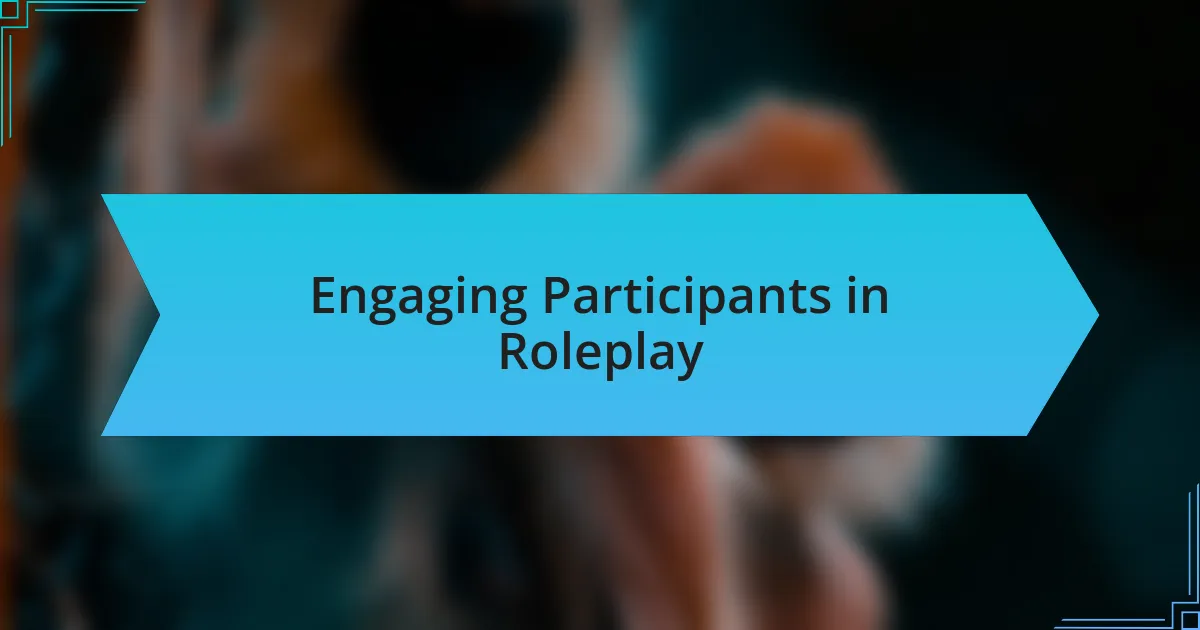
Engaging Participants in Roleplay
Engaging participants in roleplay can be incredibly effective in fostering empathy and understanding. One time, I asked participants to act out the daily life of various animals, from a squirrel gathering nuts to a dog waiting for its owner. The laughs and gasps that erupted made it obvious—when they physically embraced these roles, they began to feel the challenges and joys of their animal counterparts. Isn’t it remarkable how stepping into someone—or something—else’s shoes can shift our perspective?
I vividly remember a session where we roleplayed a day in the life of a shelter dog. Participants had to navigate obstacles like finding food, seeking shelter from the rain, and hoping for a loving home. The atmosphere turned somber as they realized the anxiety and uncertainty these animals face daily. It struck me how often we forget the hardships animals endure. Wouldn’t it be impressive if everyone could experience that deep connection to our furry friends’ struggles?
During these roleplay exercises, I encourage participants to reflect on their experiences afterward. After one particularly intense session, a participant shared that they never thought about the loyalty of a homeless dog and how it parallels their own feelings of longing for acceptance. It reminded me that sometimes, through the simple act of play, we can unlock a profound empathy that goes beyond words. Wouldn’t it be great if we could carry that awareness into our everyday lives?
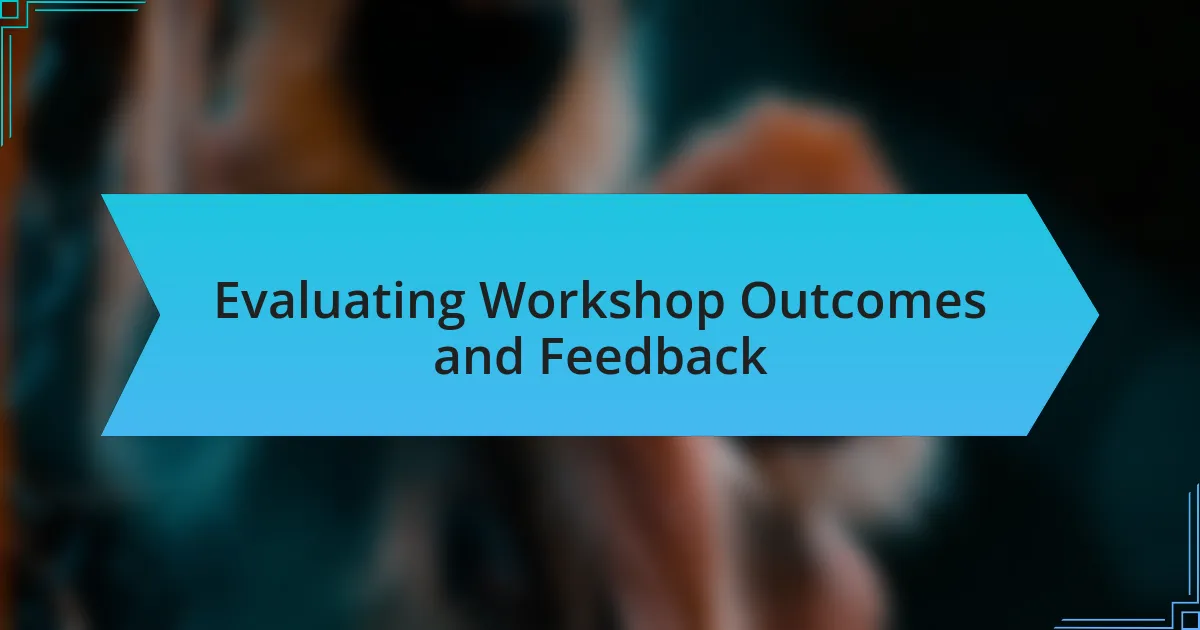
Evaluating Workshop Outcomes and Feedback
Evaluating the outcomes of the workshops requires more than just observing participants during the roleplay. After each session, I gather feedback through open discussions, allowing everyone to voice their feelings and insights. I remember one participant who shared how their experience led them to adopt a shelter dog, highlighting the direct impact these workshops can have on real-life decisions.
I often create anonymous surveys to ensure everyone feels comfortable sharing their thoughts. The responses are incredibly revealing—some participants note shifts in their attitudes toward animal welfare, while others express a newfound commitment to advocacy. It’s gratifying to see the tangible changes in perspective, and I can’t help but ask: how often do we get the chance to directly influence someone’s life in such a meaningful way?
Reflecting on the feedback also provides an avenue for my own growth as a facilitator. For instance, I learned that incorporating more real-life stories of animals enhanced emotional engagement. This insight drives me to continually refine the workshop structure, ensuring each session not only promotes empathy but also empowers participants to become advocates for animals. How can we craft experiences that resonate so deeply that they inspire action long after the workshop ends?